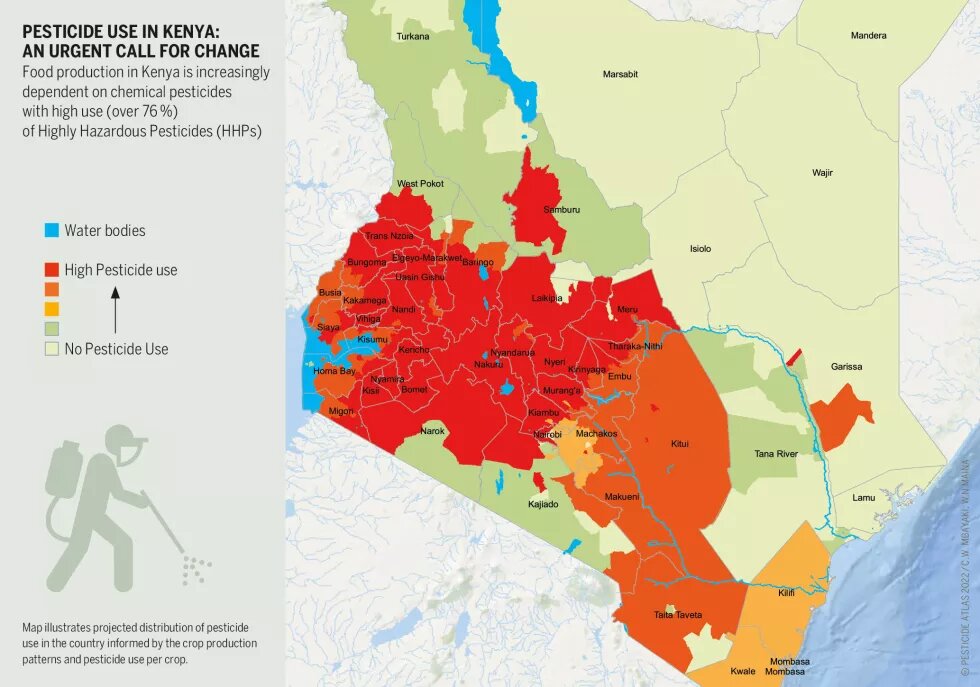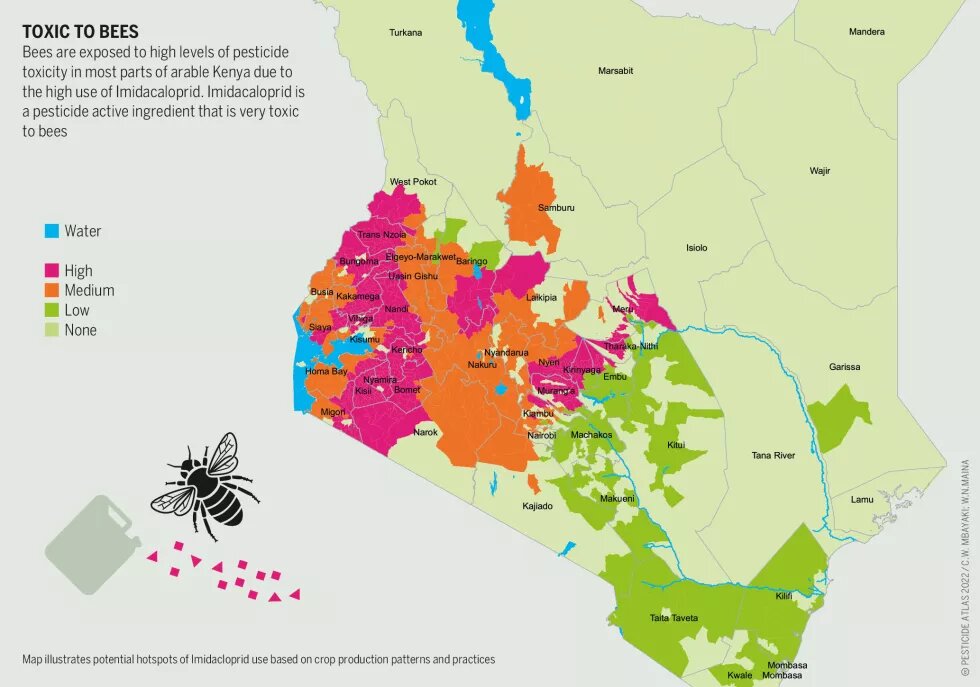
Most of the pesticides used in Kenya are highly hazardous. Toxic products are cheaper for farmers despite their negative consequences and are mostly used on maize, wheat, coffee, potatoes, and tomatoes.

Agriculture is key to Kenya's economy, accounting for about 22 percent of the overall GDP in 2021. The sector employs more than 40 percent of the total population and more than 70 percent of people living in rural areas with a high percentage of women working on farms. Most of the food is produced in a conventional farming system and relies heavily on pesticides to control various pests, fungal diseases and weeds. According to the Agrochemical Association of Kenya (AAK), pesticide imports to Kenya have increased rapidly from 6,400 tonnes in 2015 to 15,600 tonnes in 2018. However, the imported volume of pesticides alone tells us little about the risks to humans, animals, and the environment. Other factors such as the toxicity of the substances, methods of application, application rates, or the frequency of application also play a role. Detailed statistics on the use of pesticides per crop are currently unavailable in Kenya and many other African countries. Due to the lack of systematic collection of such data, sale volumes serve as proxy.
Pesticide sales data, obtained by Route to Food Initiative, shows that 76 percent of the total volume of pesticides sold in Kenya, contain one or more active ingredients that are categorized as Highly Hazardous Pesticides (HHPs) (2,353 tonnes). These are pesticides that are proven to present a particularly high level of acute or chronic risk to health or the environment. Pesticides that are not categorized as HHPs only make up 22 percent. The market value of HHPs is 46,8 million US dollars which is 64 percent of the total market share of pesticides in the country. Glyphosate, mancozeb, paraquat and chlorpyrifos are among the most used active ingredients. All in all, 44 percent of the total volume of pesticides used in Kenya are banned in Europe (1,362 tonnes). Their potential to cause severe environmental and human health effects are not acceptable.
Biological and cultural control methods for pests and diseases in Western Kenya, the Rift and Central regions are urgently needed
The high use of HHPs in Kenya is worrying because no continuous monitoring takes place. Pesticide residues on crops are mostly unknown and chronic health effects are difficult to establish. Environmental contamination of surface water, groundwater and soil are not recorded. Maize, wheat, coffee, potatoes, and tomatoes currently require the highest volume of toxic pesticides. Many of these pesticides are proven to cause cancer or genetic defects, impair fertility, or harm unborn children. To ensure consumer protection, these foods in particular need continuous monitoring for pesticide residues.
Pesticides do not only lead to health problems, many of them are also toxic to important natural resources like bees, soil and surface waters. Monitoring programs on insect diversity, water and soil quality need to be established especially in areas where these crops are cultivated. Food production relies heavily on the health of these natural resources.
Declining bee populations would be a major threat to Kenya’s food security. Currently, not enough is known about the impacts pesticides are having on local bee species. Long-term, systematic data collection is needed.
Kenya does not manufacture its own plant protection products and imports pesticides mainly from countries in the European Union (EU), China and India. Syngenta leads the pesticides market with 20 percent market share, followed by Bayer AG with 15 percent, Corteva Agriscience™ (agriculture division of DowDuPont™) with 7.7 percent, FMC Corporation with 5.7 percent and Adama Agricultural Solutions with 4.4 percent. More than half of the volume of pesticides sold by all five companies are categorized as HHPs. Some of them already banned in the country of origin.
Many importing countries are imposing stricter controls on the use of some HHPs. South Africa, the African country with the highest pesticide use on the continent, has announced the ban of HHPs by 2024. Exporting countries like France and Switzerland have already forbidden the export of pesticides that are banned in the EU. Germany has announced it will follow this course of action to end the continued trade of pesticides that are not authorized in the EU. These steps can contribute to greater implementation of an ecological approach to crop protection. However, more political will, practical research and knowledge sharing on sustainable solutions is needed in Kenya.
Although more and more farmers are interested in organic farming, the total share remains low in Kenya. Only 2 percent of the total volume of pesticides used are biopesticides, which are substances that are derived from natural materials such as animals, plants, bacteria, and certain minerals. Even if biopesticides were available, the price is higher than the price of HHPs, so farmers are not able to afford less toxic alternatives. Making alternatives to HHPs affordable and available and supporting resource efficient agricultural systems with less external inputs, are crucial for a transformation towards a more sustainable agricultural model. Success stories on the African continent are increasingly visible. It is time to show the political will to transform food systems by redirecting agricultural production away from toxic pesticides and towards the use of natural pest control mechanisms to grow healthy crops with the least possible disruption to agroecosystems and risks to human health and the environment.
This article was published in the Pesticides Atlas Kenya Edition.
